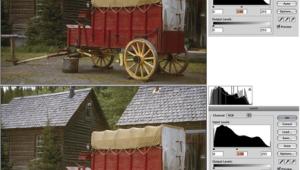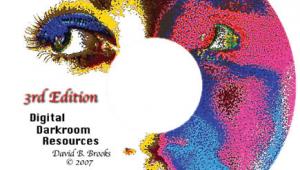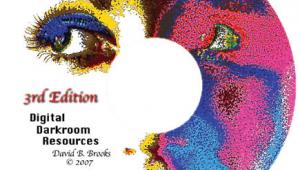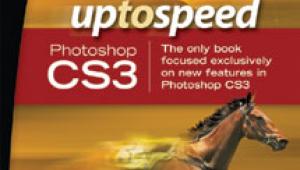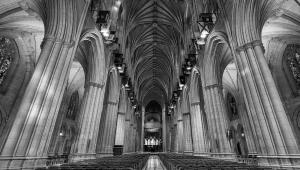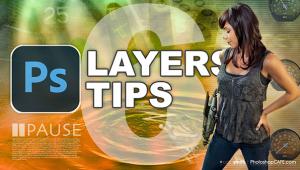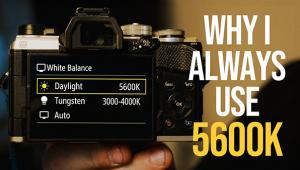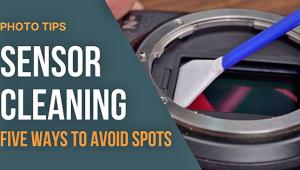Are LCD Flat Panel Displays Ready For The Digital Darkroom?
How To Choose And Use The Newest LCDs Page 2
 |
|
|
I then replaced the Sony LCD with
my Sony CRT normally used with that computer and repeated the entire process
with the same original images from my camera and slide scans.
Shortly the LaCie Photon 20 Vision II LCD display arrived. After unpacking I
set it up and installed it on another of my systems. The LaCie display controls
differ considerably from those provided with the Sony SDM-S204. The one control
(backlight with the Sony) was not available, but another "lightview"
control provided a screen brightness control that seemed to function similarly
to backlight level.
Lightview on the LaCie provides options for two basic levels, Day and Night,
and I would assume Day setting (brighter) is for a room illuminated by window
daylight and Night setting (darker) for a room illuminated by artificial light.
Under each of these two primary categories of screen brightness setting are
three usage options: Text, Movie, and Photo. Obviously I selected Photo under
the Night heading for my workroom.
Although this Night/Photo setting
provided a perceptually similar screen brightness I had found worked with the
Sony with backlight set at 50, I thought I should measure the amount of light
all of the monitor/displays produced after calibration and profiling. To do
this I got out my trusty handheld Sekonic digital studio incident light meter,
and with a new battery measured each display's output with the screen
filled by a New white image document created by Photoshop. Both my Sony CPD-G520P
and CPD-E540 CRTs measured the same EV level. The Sony SDM-S204 measured 1.1
EV brighter, and the LaCie measured 1.2 EV brighter. In other words, the LCDs,
even after being adjusted to a darker setting for photographic work, still produced
a screen brightness slightly more than twice what the CRTs produce. Incidentally,
for the sake of perspective, the LCD displays, set at their default standard
full brightness setting for general computing use, measured two full EVs more
light, or four times more light than a calibrated and profiled CRT monitor.
Again with the LaCie I repeated the processing of digital camera files, made
scans, edited and retouched in Photoshop, as well as made test prints with an
Epson Stylus Photo R800 printer. I then repeated the same work with that computer
using the Sony CRT. I then switched the LCDs using each with a different system,
again calibrating and profiling the display for the new system, and ran yet
another full set of input, editing, and output tests.
 |
|
|
Test Conclusions, Evaluations,
And Recommendations
I hoped that my testing and use of the latest in LCD display technology would
discover whether a user can achieve the same level of perceptual color control
as when using the best consumer CRT monitors. In terms of color fidelity of
an image input from a digital camera or a film scanner, I found that once the
LCD brightness level was adjusted downward and then calibrated and profiled
the differences between using these new LCD displays and a CRT are minor. This
conclusion was also supported by using software analysis of the generated profiles.
The software involved was courtesy of CHROMiX (www.chromix.com), and is called
ColorThink. It provides a multidimensional representation of the analysis of
the data that is included in an ICC/ICM profile file. One of these representations
of the profile file content is 2D Graphing, which produces a color picture that
visually defines the color space of an ICC display profile. On the basis of
a comparison of these 2D Graphs of Adobe RGB (1998) color space, there is very
little difference in the range of colors reproduced by these new LCD displays
and CRTs that could substantially affect perceptual color control and adjustment.
Other dimensions of how an LCD display affects photographic image processing
are not so easily measured. However, the fact an LCD display reproduces photographic
images with a larger range of brightness values effectively enhances the perceived
internal contrast between image tones. This is a positive value to functions
like cleanup and retouching with Photoshop. It's easier to discern differences
in tone that are image flaws and correct them accurately and smoothly with Photoshop
brush tools like RubberStamp. In addition, work like retouching that involves
acute perceptual concentration is noticeably less tiring, as LCDs do not exhibit
the subliminal flicker of the image that is characteristic to CRTs. Likewise,
the greater perceived contrast and tone distinction working with an LCD makes
doing many manipulative and creative tasks with photo images easier. When you
are selecting an image with Photoshop's Lasso or blending feathered image
objects to make a composite, it is easier to see subtle distinctions of tone
that provides more exact control over what you are doing.
On the output side, I had a more objective basis of comparison in prints of
the same image reproduced both from a system fitted with one of the LCD displays
and the CRT monitors. The prints made from LCD-generated images were somewhat
darker than the same image produced and printed with a CRT-monitored system.
Likewise, a photo image file saved with a system running an LCD transferred
to a system with a CRT, when opened in Photoshop, appeared noticeably darker
on screen. My assumption is that the longer brightness range of the LCD, when
calibrated and profiled "effectively," produces a higher gamma than
the 2.2 gamma to which it is adjusted by color management software.
This assumption seemed to be confirmed because the print darkening was more
pronounced when I used ColorVision's OptiCAL software than when I used
their PhotoCAL software to calibrate and profile the display/monitors. Looking
at this discrepancy in print output image density, it seems logical that with
a longer brightness range produced by LCDs the midpoint gray would be placed
further up the scale, considering that both scales begin at zero, or blackpoint.
Then, without compensating gamma correction by the color management system,
the midpoint gray as displayed by an LCD is mistakenly assumed to be the same
value as it would be for a CRT monitor display of that image, and prints it
darker than it appears on the LCD.
Based on my use and testing of these new, high-performance LCD displays, it
is evident that the problems with small color gamut and limited display performance
controls of earlier generations of LCD displays have been resolved. I can also
report that these new 20" models fully support effective digital photography
computing. This conclusion, however, assumes that these new generation LCD displays
are used and set up with adjustments that support working with photo images,
as well as custom calibration and profiling. It is, of course, up to each individual
whether the smaller desk footprint, lighter weight, and better image contrast
of these LCDs justifies their cost, which is currently twice that of a professional
quality 21/22" CRT monitor. Personally, as soon as my budget allows, I'll
add one to my workroom if for no other advantage than the LCD is much better
and easier on the eyes for cleanup and retouching, as well as for doing creative
manipulation and compositing work.
Breaking News--ColorVision's New Spyder2 & Spyder2PRO Monitor Calibration & Profiling
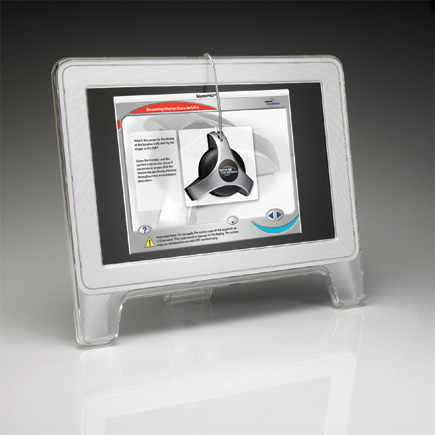
In just a few years ColorVision's
Spyder colorimeter and PhotoCAL/OptiCAL monitor calibration and profiling solution
has gained great popularity as a most effective and affordable color management
solution. Now, a new generation, the Spyder2 and Spyder2PRO, is available with
a newly designed colorimeter monitor sensor. The products feature new photo
sensors for greater accuracy, as well as a re-engineered package that provides
more effective baffling and an easier transition between using them for CRTs,
LCDs, and laptops.
The new ColorVision Spyder2 also includes new software that is Wizard-driven
and even easier to use. As important is the new Spyder2 software that includes
a more precise Gray Balance function for precise neutral tones, as well as new
Tonal Response Algorithms that provide the smoothest of value gradations and
color transitions for more controlled work and superior matched print quality.
The ColorVision Spyder2PRO package option provides more advanced critical functions,
including the ability to produce matched performance between monitors in a multi-system
work environment. The advanced features include PreCAL for precise RGB gain
balancing and luminance adjustment. Spyder2PRO also produces a graph window
to check and adjust Curve responses for each channel, allowing for a customized
tonal response. In addition, the Pro software supports use of the Spyder2 colorimeter
to make discrete color readings of screen colors. The ColorVision Spyder2PRO
package includes ColorVision's DoctorPRO, a Photoshop plug-in that supports
output profile editing. This makes the Pro package an input through output products
that yields
fine-tuned results.
For more information on the Spyder2 and Spyder2PRO, as well as availability
and pricing, visit ColorVision's website at: www.colorvision.com.
- Log in or register to post comments

